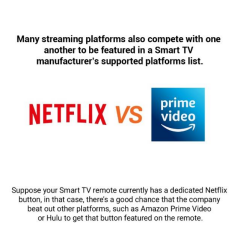Digital streaming services have changed the way we consume content in 2022. Services such as Netflix, Hulu, Amazon Prime Video, and Disney+ have become increasingly popular, and it’s not uncommon for many households to be subscribed to multiple streaming services at once. The way we access these streaming services has also shifted over the last few years. When companies like Netflix first launched their streaming services back in 2007, the only way to access the platform was using a computer, Blu-Ray players, or video game consoles. As digital streaming services grew in popularity, some companies began manufacturing streaming media players (SMP). These devices could be connected to any television with an HDMI port, and this allowed users to watch TV shows and movies through various streaming services on their televisions. Such SMPs grew more compact over time as manufacturers optimized their chipsets. This was around the time that many television manufacturers also began to take notice of the rising popularity of digital streaming services. Following this, many leading television manufacturers began producing “Smart TVs” with built-in Wi-Fi chips and support for streaming platforms. It is estimated that 87% of households in the United States contain an internet-connected TV device. This figure includes Smart and non-Smart TVs connected to the internet via SMPs

Smart TVs and SMPs Aren’t Competing With Each Other
Since both Smart TVs and SMPs work to provide users with access to digital streaming platforms, it would seem they are in direct competition with each other. After all, someone with an SMP wouldn’t need a Smart TV or vice versa to watch their favourite TV shows and films on Netflix. However, a recent study by Hub Entertainment Research discovered that 57% of Smart TVs in the United States households have external SMPs such as Fire TV or Roku attached to them.
Why Some Households Have Both Smart TVs and SMPs
This begs the question: Why would someone invest in an SMP when they already have a Smart TV? Hub Entertainment Research intends to conduct a follow-up study to determine such reasons. However, we can speculate as to why someone would invest in both devices.

Platform Exclusivity
The number of streaming platforms has grown substantially over the last 15 years. Netflix began offering streaming services in 2007, while Hulu launched its streaming platform in 2008. Today, most people can name at least half a dozen streaming services off the top of their heads. This includes Amazon Prime Video, Apple TV+, Disney+, and HBO Max. However, these are just the streaming platforms launched by billion-dollar corporations. There are over 200 streaming services available in the United States. This means people have no shortage of streaming options to choose from. However, this vast number of streaming services also comes with a significant drawback: Content exclusivity. While many streaming platforms actively compete with one another by offering consumers low monthly subscription costs. Some have also attempted to scoop up exclusive streaming rights for certain types of content.
For example, Netflix lost streaming rights to the hit NBC TV show The Office in 2020. This followed NBC’s decision to offer the show exclusively on Peacock, its new streaming platform.

There are countless examples of streaming platforms losing streaming rights to popular films and TV shows. As a result, many users have been forced to subscribe to multiple streaming platforms to watch all their favourite films and TV shows. This creates another issue in which a Smart TV might not support every single platform someone is subscribed to. In fact, many streaming platforms also compete with one another to be featured in a Smart TV manufacturer’s supported platforms list. Suppose your Smart TV remote currently has a dedicated Netflix button. In that case, there’s a good chance that the company beat out other platforms, such as Amazon Prime Video or Hulu, to get that button featured on the remote. So how do SMPs fit into all this? If a Smart TV doesn’t support each streaming platform you are subscribed to, you will need to invest in an SMP to get access to more streaming platforms.
For example, most Samsung Smart TVs support streaming services such as Netflix, Amazon Prime Video, Hulu, and Vudu. On the other hand, the Roku SMP supports dozens of streaming platforms, such as Netflix, Hulu, Disney+, Amazon Prime Video, HBO Max, Tubi, Paramount Plus, and discovery+. For this reason, it’s easy to see why someone would own an SMP when they already have a Smart TV.
Access to Live Channels
A large percentage of households across the United States no longer use cable broadband services. This change has been attributed to the rising popularity of digital streaming platforms. However, many users would still like to have access to some live channels in addition to digital streaming platforms. This is where SMPs can be useful. Many SMPs support both digital streaming platform apps as well as live channels. This means someone with a Smart TV who doesn’t have cable broadband can still watch live channels by investing in an SMP.
Will Smart TVs and SMPs Compete in the Future?
It’s difficult to predict whether Smart TVs and SMPs will compete with one another in the future. Both devices overlap in many areas but are also different enough to justify investing in both.
Smart TVs and SMPs may compete only if more of their features overlap in the future. For example, if Smart TVs began supporting more streaming platforms and live channels than they currently do. For now, these devices comfortably co-exist in millions of households across the country.
